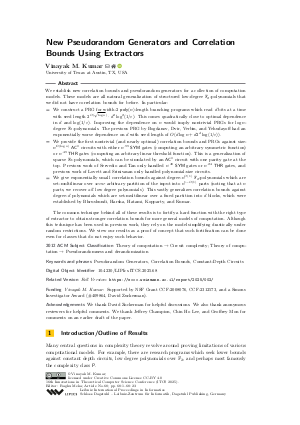LIPIcs.ITCS.2025.68.pdf
- Filesize: 0.95 MB
- 23 pages

 Creative Commons Attribution 4.0 International license
Creative Commons Attribution 4.0 International license

We establish new correlation bounds and pseudorandom generators for a collection of computation models. These models are all natural generalization of structured low-degree 𝔽₂-polynomials that we did not have correlation bounds for before. In particular:
- We construct a PRG for width-2 poly(n)-length branching programs which read d bits at a time with seed length 2^O(√{log n}) ⋅ d²log²(1/ε). This comes quadratically close to optimal dependence in d and log(1/ε). Improving the dependence on n would imply nontrivial PRGs for log n-degree 𝔽₂-polynomials. The previous PRG by Bogdanov, Dvir, Verbin, and Yehudayoff had an exponentially worse dependence on d with seed length of O(dlog n + d2^dlog(1/ε)).
- We provide the first nontrivial (and nearly optimal) correlation bounds and PRGs against size-n^Ω(log n) AC⁰ circuits with either n^{.99} SYM gates (computing an arbitrary symmetric function) or n^{.49} THR gates (computing an arbitrary linear threshold function). This is a generalization of sparse 𝔽₂-polynomials, which can be simulated by an AC⁰ circuit with one parity gate at the top. Previous work of Servedio and Tan only handled n^{.49} SYM gates or n^{.24} THR gates, and previous work of Lovett and Srinivasan only handled polynomial-size circuits.
- We give exponentially small correlation bounds against degree-n^O(1) 𝔽₂-polynomials which are set-multilinear over some arbitrary partition of the input into n^{1-O(1)} parts (noting that at n parts, we recover all low degree polynomials). This vastly generalizes correlation bounds against degree-d polynomials which are set-multilinear over a fixed partition into d blocks, which were established by Bhrushundi, Harsha, Hatami, Kopparty, and Kumar.
The common technique behind all of these results is to fortify a hard function with the right type of extractor to obtain stronger correlation bounds for more general models of computation. Although this technique has been used in previous work, they rely on the model simplifying drastically under random restrictions. We view our results as a proof of concept that such fortification can be done even for classes that do not enjoy such behavior.


Feedback for Dagstuhl Publishing